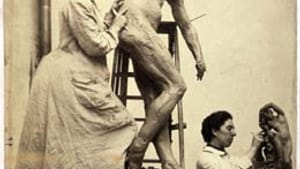Stay in the Loop
BSR publishes on a weekly schedule, with an email newsletter every Wednesday and Thursday morning. There’s no paywall, and subscribing is always free.
The making of artists

Art school is a funny dichotomy, perhaps a harsh one.
I tell my art students in maximum-security prisons, “If you survive prison, you might make excellent candidates for art school, but only if you toughened yourselves up.” I know that my students are very fragile.
Before attending the Pennsylvania Academy of Fine Arts, I was a social worker. In graduate social work school at University of Pennsylvania, common statements are “Thanks for sharing” and “ Tell me more”: phrases that convey the desire to be emphatic and compassionate, or at least, the desire to appear so.
Art school is different. In art school, I was amused, maybe shocked, by a story of Walter Stuempfig, an artist who taught at PAFA from 1948 until his death in 1970.
In the story, Stuempfig is teaching a painting class at the Peale House on Chestnut Street and asks a student, “Do you want to know what I think about your painting?” Allegedly, without waiting for the student’s reply, Stuempfig throws the painting out of the high floor studio window, letting it land wherever or upon whomever.
The truth of the Stuempfig story is not particularly important. As in all legends, the story tells us what is expected: Art school is not for the faint of heart. It demands that students, to use my grandmother’s phrase, develop broad shoulders.
Gone girl
Even art teachers who appear more compassionate can take a direct method of criticism. I had a life drawing class with the great late artist Edith Neff. While she was explaining certain points about drawing the model, Edith absentmindedly erased my entire drawing. I looked at my now blank drawing paper and said, “Edith, I guess you didn’t like my drawing.”
If Stuempfig is a larger-than-life PAFA legend, then Eddie Poole is a less recognized one. Eddie had been a model in life drawing classes for many years prior to becoming a guard at the school. He was proud of the fact, Eddie told me often, of being the first male nude to remove his G-string while modeling.
“The kids came to me one time when I was modeling and ask, ‘Eddie, do you think you could remove the G-string? It interrupts the drawing.’ After I took it off, every other male model gave up the G-string.”
During a life drawing class, Eddie is substituting for a no-show model, momentarily exchanging his guard’s uniform for nothing. Kathy, an art student for a number of years, is drawing next to me. Over the years Kathy has drawn Eddie; not as a young man, but as a younger man. With her training in nursing, Kathy looks at Eddie and then says to me, “I’m worried about Eddie.”
I have no idea as to why Kathy is worried about Eddie. However, Eddie-as-nude becomes Eddie-as-naked. The elements of vulnerability, exposure, and frailty are made even more apparent in the harshness of viewing Eddie as a model to draw instead of caring about him as person. Care asks me to cover him.
Art that is effective presents itself to the viewer, like Eddie, my prison students, as vulnerable, exposed, and frail because without elements of risks, art becomes redundant. Art cannot follow formulas; it cannot depend upon reassurances that the future will follow the past; and it becomes the manifestation of the unexpected that surpasses artist’s skills and materials if this resulting art is good art.
Being and becoming
Process never reveals outcome, outcome will never be ultimate, and art in this process may very well be erased or thrown out the window.
Consequently, in the making of me as an artist, I am asked to become a kind of chimera — a strange fragile creature with shoulders too broad existing in a place that offers no reassurances to soften the disconnect.
The reassurances given in social work school can only be given there because the premise of social work involves a certain absolute — that the subject of its focus, the person (or persons), has the right to exist.
Art is different. Art does not have such basic rights to claim existence. Art does not exist dynamically until an audience judges it worthy to exist. Without an audience, art exists in a vacuum.
Of course, the definition of audience is vast — expansive as the public or small and private as a devoted family; perhaps the audience is even illusory, a voice in the head. Whatever way the audience presents, it has the power to grant existence to art or the power to annihilate it.
Art exists in the way that speech exists. For all speech’s granted freedoms, speech means nothing if there is no listener.
But it is easy to fool the audience if that is what the artist wants to do, and not all audiences want good art. Think of your favorite scam artist. This is where marketing and branding become as or more important than the art.
Artists are asked to become good rhetoricians of their art — more than when I was an art student. When Brendon, a soon-to-be art school graduate, tells me he’s city hopping in search of gallery representation, I remember a powerful statement from Peter Paone, the formidable PAFA printmaking instructor: “No one says anything artistically until at least five years after school — spend your time in the studio.” Until I shake off the debris of schooling, I am under its total influence; forced too soon into the market, I am under the market’s control.
The studio can be the domain for positive nonexistence in pure process. (Ironically, process can be presented, forcing it to become the product that it seeks not to be.)
Gallery affiliations, BFA, MFA degrees are tangibles giving definition to this unknown process called art. They are the social work reassurances that all will be well.
My résumé credentials become the emperor’s new clothes, allowing me to forget that in the process of creating art, I stand exposed not knowing whether my efforts will exist as art; allowing me to forget that every window is high and all falls are painful.
For Treacy Ziegler's review of the Annual Student Exhibition at PAFA, click here.
Sign up for our newsletter
All of the week's new articles, all in one place. Sign up for the free weekly BSR newsletters, and don't miss a conversation.

 Treacy Ziegler
Treacy Ziegler